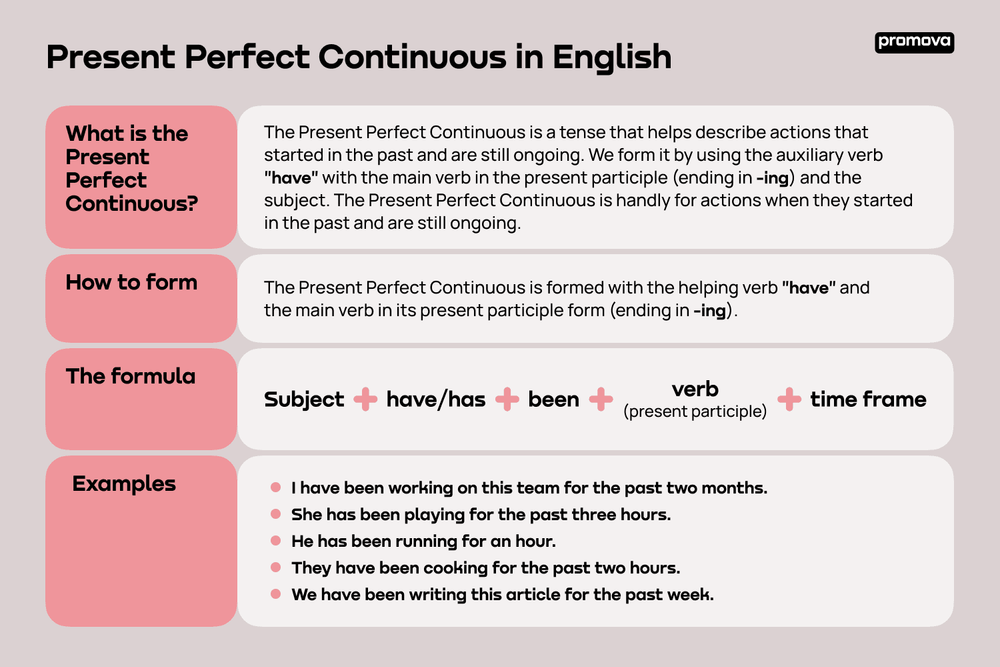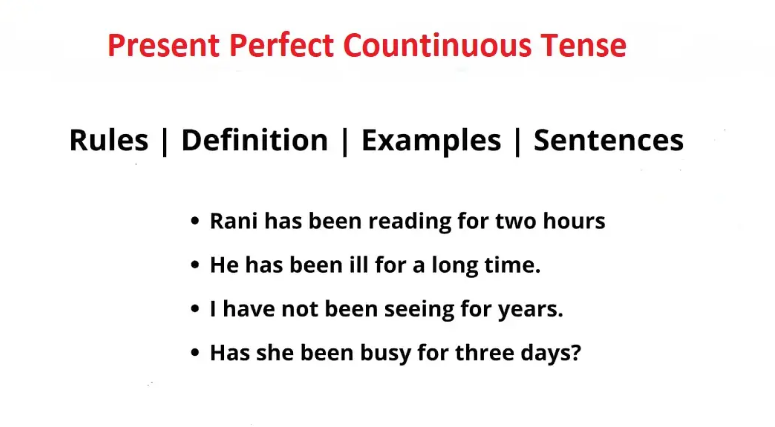IELTS Grammar – Present Perfect Continuous Tense
English grammar is a mosaic of tenses, each contributing to the depth and precision of our language. Among them, the Present Perfect Continuous Tense is a unique gem that captures actions with a temporal twist. In this essay, we will embark on a journey to unravel the mysteries of the Present perfect continuous tense, exploring its definition, structure, usage, and significance in the IELTS test, and even challenging ourselves with an exercise to master its intricacies.

1. What is the present perfect continuous tense?
The Present Perfect Continuous Tense is a grammatical structure that expresses actions that began in the past, are ongoing in the present, and are expected to continue into the future. It emphasizes the duration or the ongoing nature of an action or event. This tense is formed using a combination of “have/has been” + the base verb + “-ing.”
2. What is the structure of the present perfect continuous tense?
The structure of the Present Perfect Continuous Tense in English is as follows:
2.1. Affirmative Form
Subject + Have/Has + Been + Verb (base form + -ing)
Example:
I have been studying.
She has been working hard.
They have been playing soccer all afternoon.
2.2 Negative Form
Subject + Have/Has + Not + Been + Verb (base form + -ing)
Example:
I have not been studying.
She has not been working hard.
They have not been playing soccer all afternoon.
2.3. Interrogative Form
Have/Has + Subject + Been + Verb (base form + -ing)?
Example:
Have I been studying?
Has she been working hard?
Have they been playing soccer all afternoon?
Here’s a breakdown of each part of the structure:
- Subject: This is the person or thing performing the action of the verb.
- Have/Has: The choice between “have” and “has” depends on the subject:
- “Have” is used with “I,” “you,” “we,” and “they” (e.g., I have been working).
- “Has” is used with “he,” “she,” and “it” (e.g., She has been studying).
- Been: This word indicates the continuous aspect of the tense, signifying ongoing action.
- Verb (base form + -ing): The main verb follows “been” and is in its base form with “-ing” added to it. This form is used to indicate that the action is ongoing.
>> Suggested article: The simple continuous tense

3. What is the present perfect continuous used for?
The Present Perfect Continuous Tense is used in English for several specific purposes:
3.1. Expressing Actions Started in the Past, Continuing in the Present, and Expected to Continue into the Future
This tense is used to describe actions that began in the past, are ongoing at the present moment, and are expected to continue into the future. It emphasizes both the duration of the action and its relevance to the present.
For example:
“I have been living in this city for five years.” (I started living here in the past, and I continue to live here now, with the implication that I will likely continue to live here in the future.)
3.2. Highlighting the Duration of an Action
The Present Perfect Continuous Tense is particularly useful when you want to emphasize how long an action has been going on. It provides a sense of continuity and ongoing nature. For example:
“She has been working on the project all morning.” (This emphasizes that she started working on the project earlier in the morning and is still working on it.)
3.3. Emphasizing the Result of an Action
It can be used to emphasize the result or the impact of an action that has been happening over a period. This usage often includes phrases like “for” and “since” to specify the duration.
For example:
“They have been cleaning the house for hours.” (The emphasis is on the cleanliness of the house as a result of their hours-long cleaning.)
3.4. Discussing Recent or Ongoing Events
In conversations or written contexts, the Present Perfect Continuous Tense is used to discuss recent events or actions that have a connection to the present moment. It implies a sense of currency and relevance.
For example:
“I’ve been reading the news online today.” (This suggests that you have been reading news articles today, possibly to stay updated on current events.)
3.5. Asking Questions about Recent Activities
When used in questions, it’s often used to ask about someone’s recent activities or experiences.
For example:
“What have you been doing all day?” (This inquires about the activities or actions someone has been engaged in during the day.)
4. What is the present perfect continuous role in the IELTS test?
The Present Perfect Continuous Tense plays a significant role in the IELTS test, which assesses a candidate’s ability to understand and use English language skills effectively in grammar for IELTS and various contexts. Here’s how the Present Perfect Continuous Tense is relevant in different sections of the IELTS test:
4.1. Speaking Section
In the IELTS Speaking test, candidates may be asked about their experiences, recent activities, or ongoing actions. The Present Perfect Continuous Tense is often used to describe what they have been doing or experiencing in the recent past.
Questions may be framed to inquire about how long candidates have been doing something or how their experiences relate to the present.
For example, “How long have you been studying English?” or “What have you been doing today?”
4.2. Writing Section
In the IELTS Writing test, the Present Perfect Continuous Tense can be used in both Task 1 (Academic module) and Task 2 (both Academic and General Training modules).
- Task 1 (Academic module): Candidates may use this tense to describe changes, developments, or trends over a specific period. For instance, they might analyze a graph showing how pollution levels have been increasing.
- Task 2: When discussing contemporary issues, ongoing problems, or recent developments, the Present Perfect Continuous Tense can be employed to convey the current state of affairs or changes over time.
4.3. Listening Section
In the IELTS Listening test, candidates are required to understand spoken English in various contexts. The Present Perfect Continuous Tense is commonly used in conversations or reports to describe recent activities or situations. Candidates must comprehend the context and meaning of these tenses to answer questions accurately.
4.4. Reading Section
In the Reading section, candidates encounter passages that may include the Present Perfect Continuous Tense to describe ongoing events, trends, or developments. Understanding this tense is crucial for comprehending the meaning of the passages and answering related questions.

5. Challenge yourself with the present perfect continuous tense exercise
Ex1: Fill in the blanks with the correct form of the verb in the Present Perfect Continuous Tense:
She (read) ________________ that book for two hours.
They (play) ________________ basketball since this morning.
I (study) ________________ Spanish for six months.
How long (you / wait) ________________ for the bus?
He (work) ________________ at the company for five years.
Answers:
She has been reading that book for two hours.
They have been playing basketball since this morning.
I have been studying Spanish for six months.
How long have you been waiting for the bus?
He has been working at the company for five years.
Ex 2: Fill in the blanks with the correct form of the verb in the Present Perfect Continuous Tense.
I (read) ________________ that novel for two weeks.
They (work) ________________ on the project all day.
She (paint) ________________ the walls since morning.
How long (you / learn) ________________ French?
We (wait) ________________ for the results for hours.
Answers:
I have been reading that novel for two weeks.
They have been working on the project all day.
She has been painting the walls since morning.
How long have you been learning French?
We have been waiting for the results for hours.
Ex3: Form questions using the Present Perfect Continuous Tense for the following statements.
He has been swimming.
They have been studying.
She has been baking a cake.
I have been gardening.
We have been hiking.
Answer:
Has he been swimming?
Have they been studying?
Has she been baking a cake?
Have I been gardening?
Have we been hiking?
In the intricate tapestry of English grammar, the Present Perfect Continuous Tense stands as a vibrant thread, capturing the essence of actions that bridge the past, present, and future. Through our exploration of its definition, structure, usage, role in the IELTS test, and exercises, we have unveiled a tense that excels at expressing the ongoing nature of experiences and the persistence of actions.
In mastering the Present Perfect Continuous Tense, we embrace a richer dimension of English, one that mirrors the dynamic nature of our experiences and paints a vivid canvas of our lives. As language users, we harness this tense to convey the tapestry of our actions, our experiences, and our ongoing connection to the world around us, bridging time, understanding, and expression in a beautiful linguistic mosaic. If you want to get a high score, take our IELS practice test now!